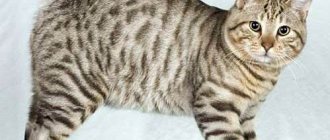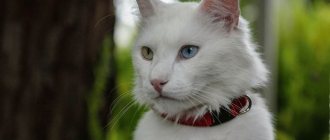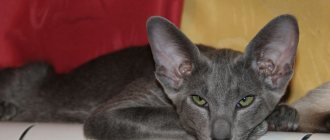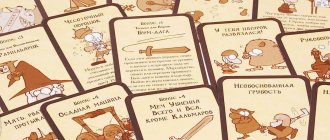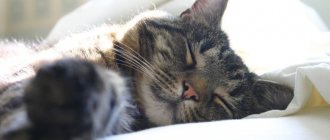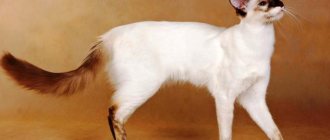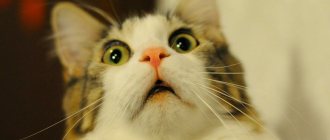History of the origin of the breed
Many of the stories indicate that the first representatives appeared around the 40s of the last century. It was at this time that a British breeder was transporting Abyssinian kittens to New Zealand, North America and Australia.
This was not a planned breeding. The ancestors of the Somalis are the short-haired Abyssinians. There are two versions of the appearance of the Somalis:
- As a result of a gene mutation, short-haired Abyssinians, as an exception, gave birth to long-haired kittens.
- The Abyssinian cat was unplannedly crossed with an unknown longhair cat.
The history of the breed is silent about which version is correct, but it is known that it was thanks to the Abyssinian cat that such a wonderful breed appeared.
Corsican legends
For centuries, Corsican shepherds have told stories of strange animals that attack cows and sheep. These animals tried to attack the udders of livestock. There have also been attacks on chicken coops.
The unusual animal looked like both a cat and a fox. Legends about this animal have been passed down from generation to generation. The locals called it ghjattu volpe, which means “cat-fox” or “cat fox” in Corsican.
For a long time, scientists considered these myths to be fiction. It was assumed that Corsican peasants mistook ordinary cats for a new species of animal.
However, the fox cat does exist. In 2008, this animal was caught in a chicken coop in northern Corsica. The new species of mammal leads a predominantly nocturnal and secretive lifestyle. The cat-fox lives in remote and deserted places. That is why for many centuries it was impossible to catch it.
Urgent price rise: suppliers warned of a 78% rise in sugar prices
Modern interactive format: teacher bloggers challenge stereotypes
Few people knew that Agutin had an eldest daughter. Polina looks so much like her father
Description of the breed
The standard and characteristics of the Somali cat breed are practically no different from the Abyssinian standards. The main difference is the length of the coat.
The Somali breed is impressive in its appearance - the cats are very similar to a fox or a squirrel. Pets with a characteristic color, fluffy tail and beautiful fur can conquer any heart.
Adults reach medium size. Pets weigh approximately 4-6 kilograms.
Breed standard
The Somali cat breed has many names among the common people. The most interesting of them are the squirrel cat or the fox cat. But no matter what name the breed has, the general standards remain unchanged.
Somalis have a long and fluffy double coat, the thicker it is, the better. Despite the fact that the wool is thin, it is very soft. The length is not uniform, a little shorter on the paws, longer on the back, and the longest in the belly area.
| Part of the body | Description |
| Head | It has a wedge-shaped shape, without flat lines and elongation (like a fox), smooth lines of eyebrows, cheekbones and profile. |
| Eyes | Large, almond-shaped. They stand out with a dark outline, which seems to be drawn with a pencil around the eyes. |
| Body | Very flexible and graceful, medium length, well muscled, slightly arched back and rounded chest. |
| Ears | Large size, pointed towards the top. On the inside there are characteristic tufts of fur that reach the other edge of the ear. |
| Paws | Medium length, proportional to the body. In a standing position, the porridge with a tail like a squirrel gives the impression of a very nimble and fast animal. |
| Tail | Fluffy, thick at the base and slightly tapering towards the end. |
Coticus subbush. Scientists have found a new species of cat in Corsica, and it hides better than a ninja.
Employees of the French Wildlife Authority have found and filmed a new species of cat discovered on the island of Corsica. The predator has long fangs, the habits of a secretive ninja, and local residents make up frightening legends about him. But journalists do not share the opinion of scientists.
A new species of cat found on the Mediterranean island of Corsica was reported by Agence France-Presse (AFP) on June 19. Since 2008, local residents have complained about a predator who ravaged chicken coops and stole milk at night. In 2012, employees of the French State Office for Wildlife (ONCFS) opened a hunt for the offender and installed incense sticks in the forests that could attract the attention of wild animals.
The results were not long in coming: in the same year, researchers discovered fur particles on the sticks. Using a DNA test, experts determined that the predator is a cat that does not belong to a species already known to mankind. ONCFS chief ecologist Pierre Benedetti explained that the discovery was a revelation for scientists.
Based on DNA, we were able to distinguish it from the European forest cat Felis silvestris. The data is close to the African steppe cat Felis silvestris lybica, but its exact identity has yet to be determined.
According to ONCFS field researcher Carlo-Antone Cecchini, during its life in Corsica the animal became an integral part of local mythology. From generation to generation, people told each other legends about dangerous forest cats that come at night. In the Corsican dialect they called the beast ghjattu-volpe. The second part of this word is translated from Italian as “fox”.
Using traps and hidden cameras, specialists managed to track and catch 12 individuals. This happened in 2016, at the same time experts installed chips on the animals to track their habits and location and released them into the wild.
The body length of the animal is 90 centimeters. He has very wide ears, short mustaches and highly developed fangs. The predator has no external resemblance to a fox. The cat got its nickname because of the rings on its tail and its black tip.
Another distinctive feature of the animal is its dense, soft fur, which protects the owner from fleas, ticks and lice.
This is a wonderful discovery,” Benedetti told reporters.
But neither thick fur nor sharp claws can save them from their furry relatives. The individual in all photos is a male between four and six years old. According to ONCFS workers, he injured his right eye in a fight with another male. The result of the contraction is reminiscent of heterochromia - a genetic feature expressed in different colors of the iris of the eyes.
His right eye was damaged in a fight with another male
How did the animals manage to hide from local residents and scientists for years? Experts have determined that the cat-fox lives in places remote from humans, prefers to settle near bodies of water densely overgrown with grass, and is nocturnal. The main danger to her life is not people, but golden eagles, whose size is not inferior to that of a cat.
To see a kitty in action, you don’t have to go to Corsica and risk your life. The agency shared a video of experts examining the animal.
Benedetti has a theory that the cat-fox came to Corsica in the 7th century BC, and was brought by local farmers. According to his assumption, the animal’s homeland is the Middle East. Researchers have not yet found out what kind of food the animal prefers, or whether it lives in groups. This remains to be seen.
Despite the reasoning of experts, a correspondent for Hi-News suggests that scientists risk making a mistake in considering the cat-fox a new species. According to the journalist, the predators may be a hybrid of two species of wild cats from the neighboring island of Sardinia.
No less amazing than the fox cat, the animal is called the civet and lives in Africa. If you haven't heard of this fluffy one yet, it's time to watch him drink milk. After all, the beast does not know how to do this.
People can also be deprived of seemingly basic skills. For example, a woman named Debbie can't take selfies. But that didn’t stop her from launching the most divine PR campaign on Facebook.
Character
The Somali cat has an excellent character. Representatives of this breed are considered very friendly and get along well with any pets. They are calm with parrots, hamsters and fish.
A cat with a squirrel tail is easy to teach commands. If desired, it can be taught simple commands. She easily finds a common language with children and endures all their unconscious bullying with courage. Playing with Somali cats is a pleasure.
Representatives of the Somali breed are very fond of attention from others, but at the same time they have a sense of tact, and they will never impose themselves. They love to sit on their hands.
They are incredibly curious and playful, so it is advisable that they always have a sufficient number of toys. One of the main qualities is perseverance; they always try to achieve what they want, but they do it wisely.
Somali cat is a sensitive beauty with a “fox” tail
Not all cats walk on their own. Some people prefer company. The Somali cat is a friendly, gentle pet . These unusual beauties were not recognized as a separate breed for a long time. The cats were considered a waste of Abyssinians, and were given away as pets without documents.
Everything changed when in 1972, a breeder of Somali cats, contrary to the rules, brought several of her pets to an exhibition in Canada. Cats with fox tails won the hearts of the judges, and the breed was officially recognized.
Features of care
Caring for a cat of the Somali breed is practically no different from caring for other purebred cats. It is important to remember a few basic rules:
- You need to brush your pet 1-2 times a week (during shedding, you need to do this more often).
- You should definitely clean your ears once a week.
- It is advisable to brush your teeth every day.
Bathing should occur approximately once every two months. Cats relate well to water, some even take baths with great pleasure. (The water should be without chlorine, and the shampoo should be of high quality).
A small kitten definitely needs to buy a special toy so that it does not play with all the small household items.
Nutrition
The Somali cat is not picky about food. It is advisable to feed 2 times a day. Food can be of two types:
- based on dry food;
- based on natural products.
Mating and breeding
The Somali cat is descended from the Abyssinian breed, so sometimes these breeds are mated with each other to improve the offspring. You can breed a Somali cat no earlier than she is one year old.
Many representatives of this breed are infertile, so very often absolutely healthy pets do not give birth.
The gestation period lasts 65 days, during which time the cat needs special attention and care from the owner. Kittens should not be separated from their mother before they are 3 months old.
Photos of Abyssinian cats
At the end of the article we would like to offer you a selection of photos. They clearly show the breed and independent character of the Abyssinian cat.
Abyssinians are very attached to their owner. Therefore, they need to be socialized from birth, accustoming them to people. A properly built relationship between the acquired baby and the owner will become the key to true friendship and trusting relationships between an adult Abyssinian and a person in the future.
Cost and choice of kitten
There are quite a lot of Somali breeders, so it is not difficult to purchase a purebred kitten. Somali kittens are relatively inexpensive. Prices range from $170-250. If a Somali kitten does not have documents and pedigree, then it will cost much less.
When choosing a pet, you should definitely pay attention to the kitten’s parents. On their appearance, health, care, nutrition and character.
For breeding Abyssinian and Somali kittens, one nursery is most often used. The kitten standards are almost the same, the difference is that the Somali kitten has long hair. Using an Abyssinian cattery to breed Somalis helps to avoid the culling of short-haired kittens.
There are several such nurseries in Russia. One of them is located in Moscow.
Interesting facts about the Abyssinians
The breed and personality of the Abyssinian cat is a mixture of something unusual, so you can find many interesting facts about it. We would like to present to your attention a few of them:
- Since Abyssinians are similar in character to dogs, a cat can be trained to fetch a ball in its teeth. Other breeds do not have such an interesting skill;
- According to statistical data, Abyssinians most often have males in their litter. There are an average of four cats per female;
- Many owners of these graceful beauties claim that their pets can hypnotize with their gaze. And during active play, they can suddenly fall asleep, taking unusual positions in their sleep.
In addition, Abyssinians can climb rocks well and disguise themselves as animals of the mustelid family (ferrets).
